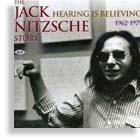
It may have only reached number 39 on Billboard‘s Pop Singles chart in 1963, but “The Lonely Surfer” is as perfect as any 21/2 minutes in rock history.
Bill Pittman’s Danelectro six-string bass enters, playing the Duane Eddy-esque melody over a medium-gallop drumbeat, supported by unwavering rhythm guitars, with a triangle marking the 3, and claves or castanets accenting every “and.” At 0:25, strings begin to swell for the repeat of the A section, holding the tonic for 21 seconds before overtaking Pittman for a variation on the third statement of the melody. At 1:05 the simple melody is repeated a fourth time, with French horns stepping in front of the strings, and tympani rolls pushing each turnaround back to the top. At 1:27 the strings regain center stage for the bridge, with sustained tremolo guitar chords and cymbal crashes punctuating each measure’s downbeat. At the release, at 1:48 into the instrumental, the six-string bass moves out front again, modulating the melody up a fourth, with strings and brass underlining it. For the last verse, French horns blare like conch shells signaling the arrival of Viking ships. Even though the song fades at 2:33, its mood is still building, as the orchestra begins the mantra-like head yet again.
This is no mere rock and roll ditty; this is a work of orchestral genius. And the genius who co-wrote it, conducted it, and, most important, arranged it was Jack Nitzsche. Phil Spector’s former right-hand man didn’t play an instrument on “The Lonely Surfer” or many of the songs he was associated with. He didn’t have to. His stamp was already all over them.
This 26-track compilation, subtitled The Jack Nitzsche Story, 1962-1979, represents just a fraction of one of the most impressive resumes in rock history. Either because of licensing obstacles or artistic decisions, this is not a “greatest hits,” in that many of Nitzsche’s best-known collaborations (arranging Ike & Tina’s “River Deep, Mountain High” and the Crystals’ “Be My Baby,” playing piano with Crazy Horse and on various Stones cuts) aren’t included. Instead, however, are forgotten and lesser-known (but equally worthy) gems like the ever-versatile Frankie Laine’s “Don’t Make My Baby Blue,” Jackie DeShannon’s original version of “Needles And Pins” (co-written by Nitzsche and Sonny Bono), Lesley Gore’s hard-edged “No Matter What You Do” (produced by Quincy Jones – no slouch as an arranger himself – but arranged by Jack), and Terry Melcher producing his mom, Doris Day, on the surprisingly hip “Move Over Darling.” Later tracks include Mink DeVille, Gram Parker and Nitzsche’s Oscar-nominated score for One Flew Over The Cuckoo’s Nest.
Personnel listings, which would take up a couple of booklets, are unfortunately not included, although the liner notes mention Ry Cooder playing guitar on “Sister Morphine” by Marianne Faithful. Elsewhere, it’s a safe bet Los Angeles’ usual studio suspects (Tommy Tedesco, Glenn Campbell, et. al.) are supplying guitar parts. But, for once, the spotlight is on the arranger – in this case, the best in rock history.
This article originally appeared in VG‘s Oct. ’05 issue. All copyrights are by the author and Vintage Guitar magazine. Unauthorized replication or use is strictly prohibited.

